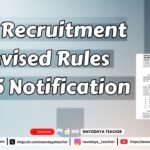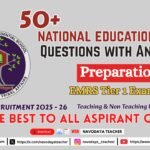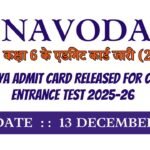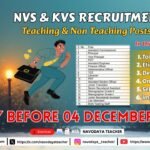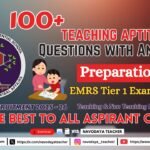In this article we providing information regarding latest 50 NEP Questions with Answers for EMRS Tier 1 Exam 2025-26
50 NEP Questions with Answers for EMRS Tier 1 Exam 2025-26
We are Providing To the Point Content for the your Upcoming Examination EMRS Tier 1 Exam 2025-26.
This will Helpful For TGT, PGT and All other Posts.
1. Who prepared the National Education Policy 2020 (NEP 2020)?
- (a) Kothari Committee
- (b) K. Kasturirangan Committee – Answer
- (c) S. R. Ranganathan
- (d) Central Board of Secondary Education
2. Who is the Chairperson of NEP 2020 ?
- (a) Narendra Modi
- (b) Daulat Singh Kothari
- (c) S. R. Ranganathan
- (d) Dr. K. Kasturirangan – Answer
3. According to NEP 2020, the curriculum is divided into four stages as per the cognitive development of the child. What is the correct sequence?
- (a) Foundational, Preparatory, Middle, Secondary – Answer
- (b) Preparatory, Foundational, Middle, Secondary
- (c) Foundational, Middle, Preparatory, Secondary
- (d) Foundational, Higher, Middle, Preparatory
4. What is the new pattern replacing the 10+2 system in NEP 2020?
- (a) 5+3+4+3
- (b) 5+3+3+4 – Answer
- (c) 5+3+3
- (d) 5+4+3+3
5. In the New Education Policy 2020, what is the new name given to the ‘Ministry of Human Resource Development’?
- (a) Ministry of Human Resource
- (b) New Education Ministry
- (c) Ministry of Development
- (d) Ministry of Education – Answer
6. In the New Education Policy 2020, what is the stage called for the first five years?
- (a) Middle Stage
- (b) Foundation Stage – Answer
- (c) Secondary Stage
- (d) Preparatory Stage
7. What is the full form of NEP?
- (a) New Education Policy
- (b) National Education Policy – Answer
- (c) National Exchange Policy
- (d) National Exam Policy
8. When was NEP recently revised?
- (a) 2010
- (b) 2014
- (c) 2009
- (d) 2020 – Answer
9. NEP 2020 is which number of National Education Policy of India?
- (a) First
- (b) Second
- (c) Third – Answer
- (d) Fifth
10. In which years has India implemented National Education Policies so far?
- (a) 1968
- (b) 2020
- (c) 1986
- (d) All of the above – Answer
11. After how many years has the New Education Policy been implemented in India?
- (a) 34 years – Answer
- (b) 36 years
- (c) 38 years
- (d) 40 years
12. From which class will vocational education start according to the National Education Policy 2020?
- (a) Class 5
- (b) Class 6 – Answer
- (c) Class 10
- (d) Class 12
13. Which course has been discontinued under the New Education Policy 2020?
- (a) D.El.Ed
- (b) B.Ed
- (c) M.Phil – Answer
- (d) All of the above
14. According to NEP 2020, after how many years of vocational study will a diploma be awarded?
- (a) 1 year
- (b) 2 years – Answer
- (c) 3 years
- (d) 4 years
15. According to the National Education Policy 2020, what is now required to pursue a Ph.D.?
- (a) 2-year bachelor’s degree
- (b) 3-year bachelor’s degree
- (c) 4-year bachelor’s degree – Answer
- (d) 5-year bachelor’s degree
16. What is the student-teacher ratio mentioned in the National Education Policy 2020?
- (a) 30:1 – Answer
- (b) 25:1
- (c) 35:1
- (d) 40:1
17. According to the National Education Policy 2020, for whom will the ‚National Assessment Centre‛ be established?
- (a) Teachers
- (b) Students
- (c) Parents
- (d) All of the above – Answer
18. What is the name of the ‚National Assessment Centre‛ established for student evaluation?
- (a) DIKSHA
- (b) PARAKH – Answer
- (c) NPS
- (d) NCERT
19. Which of the following statements is proposed in the National Education Policy 2020?
- (a) Schools should encourage students to learn and speak English as the first language.
- (b) Learning in the mother tongue is a hindrance to educational and technological progress.
- (c) Being multilingual offers high cognitive benefits to children. – Answer
- (d) Bilingual approach creates confusion among learners.
20. According to the National Education Policy 2020, what are the objectives of assessment?
- (i) To create stress and fear among students to ensure learning levels.
- (ii) To repeat teaching-learning activities.
- (iii) To make learning and development adaptive.
- (iv) To support students inside and outside the classroom.
- (a) (i), (ii) and (iv)
- (b) (i), (iii) and (iv)
- (c) (ii), (iii) and (iv) – Answer
- (d) (i), (ii) and (iii)
21. What does the National Education Policy 2020 recommend?
- (a) Monolingualism
- (b) Multilingualism – Answer
- (c) Standardization of curriculum
- (d) Standardization of assessment
22. What major change is proposed in the National Education Policy 2020?
- (a) Standardization to flexibility – Answer
- (b) Formative to summative assessment
- (c) Understanding structures to learning for exams
- (d) Multilingualism to rigidity
23. What is the full form of MERU mentioned in NEP 2020?
- (a) Multidisciplinary Education and Research University – Answer
- (b) Multilingual Education and Research University
- (c) Multidisciplinary Education and Rebuild University
- (d) Multidisciplinary Environment and Research University
24. What is the purpose of the National Assessment Centre PARAKH?
- (a) Setting questions and conducting exams
- (b) Setting norms, standards, and guidelines – Answer
- (c) Preparing question papers for board exams
- (d) Preparing question papers for UGC
25. What does “ABC” stand for as per NEP 2020?
- (a) Academic Bank of Credit – Answer
- (b) Primary Education
- (c) Both of the above
- (d) None of these
26. What term is used in NEP 2020 for pre-school level 3?
- (a) Bal Vatika – Answer
- (b) Bal Vikas
- (c) Balwadi
- (d) Anganwadi
27. At which level of school education is the minimum level of learning mentioned in NEP 2020?
- (a) Pre-school
- (b) Primary
- (c) Pre-school and Primary – Answer
- (d) Secondary
28. What kind of activities are suggested for children in early classes according to NEP 2020?
- (a) Home-based
- (b) Subject-based
- (c) Assessment-based
- (d) Creative, exploratory, age & development appropriate – Answer
29. By which year will a 4-year integrated B.Ed. degree be made mandatory as the minimum qualification for teaching?
- a) 2021
- (b) 2025
- (c) 2028
- (d) 2030 – Answer
30. What has MHRD proposed to establish under NEP 2020?
- (a) National Mission on Foundational Literacy and Numeracy – Answer
- (b) Higher Education Commission
- (c) National Research Foundation
- (d) None of these
31. According to NEP 2020, up to which class should the teacher teach in mother tongue or regional language?
- (a) Class 3
- (b) Class 4
- (c) Class 5 – Answer
- (d) None of these
32. What is the targeted Gross Enrolment Ratio (GER) for higher education institutions as per NEP 2020?
- (a) 25%
- (b) 30%
- (c) 40%
- (d) 50% – Answer
33. Who introduced the concept of core elements in the Social Studies curriculum?
- (a) NEP-1986 – Answer
- (b) NCF-2005
- (c) NCERT
- (d) SCF-2011
34. According to NEP 2020, what is the role of Mathematics and Mathematical thinking in education?
- (a) To emphasize diversity of new methods and ideas
- (b) To focus on exam techniques instead of outcomes
- (c) To separate it from other subjects
- (d) To develop convergent thinking in mathematics – Answer
35. What was the major educational objective of NEP 1986?
- (a) Universal access and enrolment – Answer
- (b) Universal education
- (c) Universal retention
- (d) Universal primary education
36. In the context of PARAKH, included in NEP 2020, what does ‘P’ stand for?
- (a) Performance – Answer
- (b) Policy
- (c) Problem
- (d) Production
37. In NEP 2020, what is the stage called for the first five years?
- (a) Middle Stage
- (b) Foundation Stage – Answer
- (c) Secondary Stage
- (d) Preparatory Stage
38. Which of the following statements regarding NEP 2020 is/are correct?
- (1) The policy aims to spend 6% of GDP on education.
- (2) The three-language formula will be implemented strictly.
- (3) A ‚National Mission on Foundational Literacy and Numeracy‛ will ensure basic skills up to class 5 by 2025.
(a) Only (1) – Answer
(b) Only (1) and (3)
(c) Only (2) and (3)
(d) (1), (2) and (3)
39. The ‚National Mission on Foundational Literacy and Numeracy‛ is related to which organization ?
- (a) NCERT
- (b) MHRD
- (c) N.E.P.
- (d) All of the above – Answer
40. How many additional seats will be added in higher education institutions, including vocational education, under NEP 2020?
- (a) 2.5 crore
- (b) 2.7 crore
- (c) 3.2 crore
- (d) 3.5 crore – Answer
41. According to NEP 2020, select the correct statements about improvement in school curriculum and pedagogy.
- Focus on critical thinking and experiential learning.
- Distinction between curricular and extracurricular activities.
- No rigid separation between vocational and academic subjects.
(a) 1, 2 and 3 are correct
(b) 1 is wrong, 2 and 3 are correct
(c) 1 and 3 are correct, 2 is wrong – Answer
(d) Only 3 is correct
42. Which ministries and departments are included in the planning and implementation of ECCE 2020?
- (a) MHRD, WCD, HFW, STC – Answer
- (b) ME, NCERT, RSCERT, NETP-92
- (c) MHRD, NCERT, HFW, NEP-2020
- (d) MHRD, ME, RTE-2009, NEP-2020
43. Which national institution has been proposed in NEP 2020 for the promotion, preservation, and development of Indian classical languages like Pali, Persian, and Prakrit?
- (a) NELC-2020 – Answer
- (b) IITI
- (c) NUEPA
- (d) NIEPA
44. When did MHRD initiate the collaborative, inclusive, and participatory consultation process regarding NEP 2020?
- (a) May 2016
- (b) June 2017
- (c) January 2015 – Answer
- (d) May 2019
45. When was the report of the committee formed for developing the New Education Policy submitted?
- (a) May 2016
- (b) June 2016 – Answer
- (c) July 2016
- (d) July 2017
46. Who chaired the committee that submitted the report for developing the New Education Policy?
- (a) T.S.R. Subramanian
- (b) K. Kasturirangan – Answer
- (c) Yashpal Sharma
- (d) Krishan Kant Sharma
47. NCPFECCE is related to which age group?
- (a) 0–3 years and 3–8 years – Answer
- (b) 0–8 years and 9–12 years
- (c) 6–11 years and 12–19 years
- (d) 8–11 years and 11–14 years
48. NEP 2020 emphasizes which kind of assessment?
- (a) Regular summative assessment
- (b) Only formative, not summative assessment
- (c) Regular formative instead of summative assessment – Answer
- (d) Both (b) and (c)
49. In NEP 2020, what does NETF stand for?
- (a) National Educational & Teaching Fundamental
- (b) National Educational & Technological Forum – Answer
- (c) National Educational & Training Framework
- d) None of the above
50. What is the ‚Gender Inclusion Fund‛ related to?
- (a) NEP 2020 – Answer
- (b) NCPSE 2022
- (c) HCF 205
- (d) NEP 1986
Thanks to Beloved Readers.

